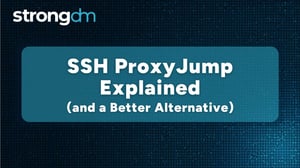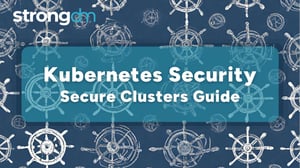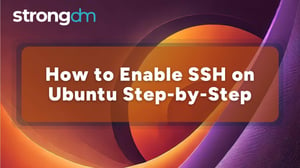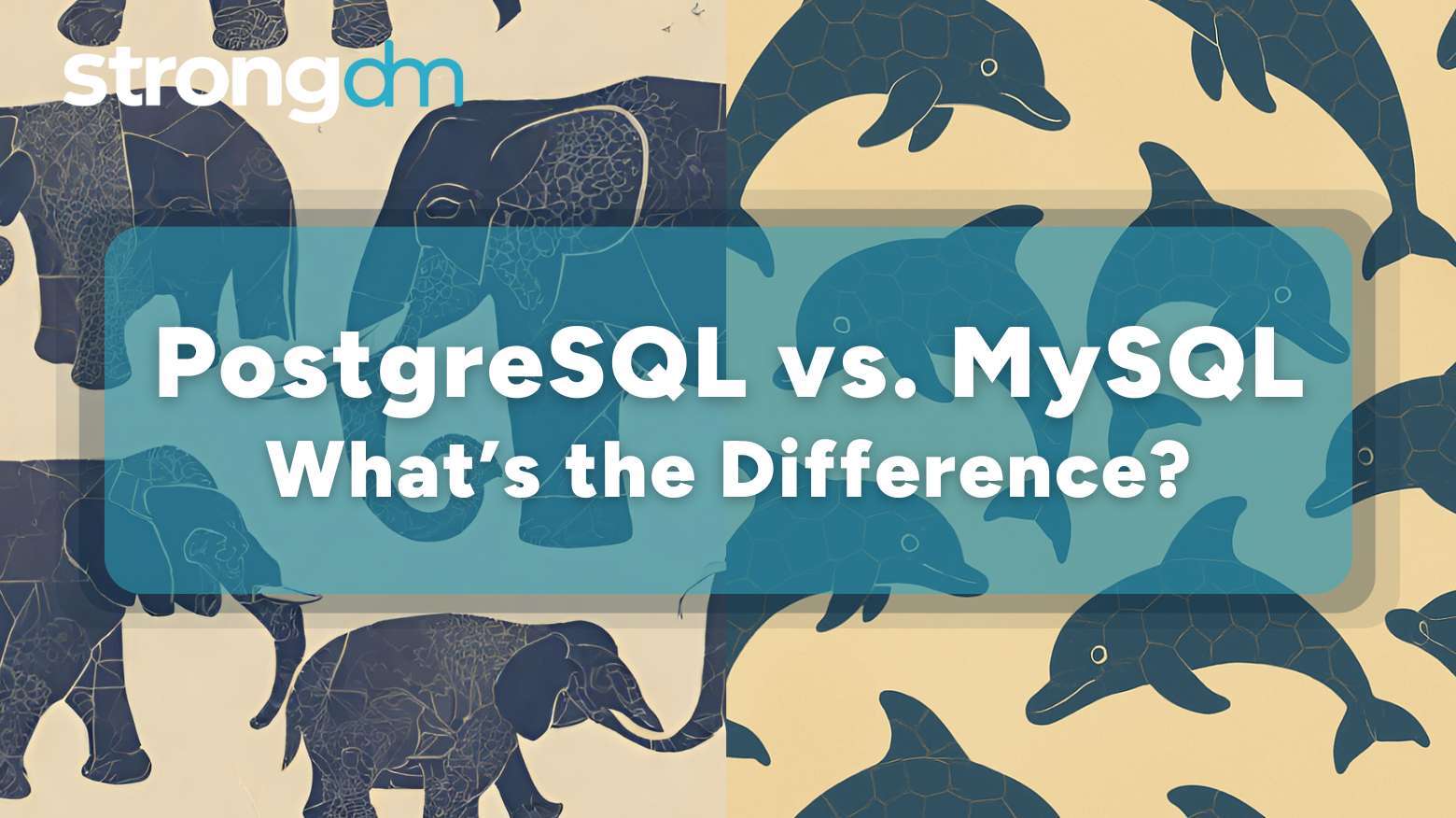

Written by
StrongDM TeamLast updated on:
July 2, 2025Reading time:
Contents
Built for Security. Loved by Devs.
- Free Trial — No Credit Card Needed
- Full Access to All Features
- Trusted by the Fortune 100, early startups, and everyone in between
PostgreSQL or MySQL? It’s the age-old database debate. PostgreSQL shines for complex, write-heavy workloads, rich data types, and ACID compliance. MySQL is fast, lightweight, and perfect for read-heavy web apps and MVPs.
But here’s the real challenge: managing secure access across both.
Whether your teams use PostgreSQL for finance and analytics or MySQL for ecommerce and dashboards, ensuring consistent, secure, and auditable access across environments is a top concern for modern technical teams.
Understanding Database Management Systems
A database management system is software that allows users to formulate, manage, and interact with databases. While PostgreSQL and MySQL both fall into this category, they’re innately different.
MySQL is purely relational, and it prioritizes simplicity and speed above all else. It’s worth noting, however, that JSON support gives it semi-structured capabilities. PostgreSQL is more complex and primarily an object-relational database. Because it’s incredibly feature-rich and extensible, PostgreSQL is often preferred when handling complex queries and write-intensive workloads.
Here’s a more detailed look at these DBMS titans.
Core Features and Capabilities
Standards Compliance
Among all open-source RDBMS, PostgreSQL is arguably the most SQL compliant. Not only does it adhere strictly to ANSI SQL standards, but it also natively supports advanced SQL features like window functions, recursive queries, partial indexes, and full-text search.
While extremely popular, MySQL is known to make trade-offs on SQL compliance for performance and ease of use. Recent versions have had significant improvements, but there’s still a noticeable lack of support for quite a few advanced SQL constructs. This is especially apparent when using non-InnoDB engines.
Extensibility
Extensibility is PostgreSQL’s beating heart. Want to define custom data types, operators, indexing methods, and even load extensions like PostGIS for spatial data? It's easy.
My SQL is a little less extensible in comparison. While there are plugins, creating and deploying them requires deeper internal knowledge and might even limit you to built-in syntax and storage engines.
Indexing Options
PostgreSQL supports diverse index types, including:
- B-tree (default)
- GIN (generalized inverted index)
- GiST, BRIN, SP-GiST
- Partial indexes and expression-based indexes
MySQL supports two popular indexes: B-tree and full-text indexes ( e.g., InnoDB supports FULLTEXT). The latter might have some limitations, though, depending on the storage engine used.
Views
Does PostgreSQL support both regular and materialized views? The answer is a resounding yes. Both are pre-computed and stored for swift read access. Because you can refresh them on demand, they’re particularly ideal for expensive joins or aggregations.
As for MySQL, it only supports non-materialized access. That means query execution is on access.
ACID Compliance and Transaction Support
PostgreSQL takes compliance seriously. It’s no different for ACID principles (atomicity, consistency, isolation, durability). This means, regardless of an error or failure, PostgreSQL will facilitate full transaction isolation. Yes, even serializable for the most demanding use cases—think financial systems, compliance-heavy environments, and enterprise-grade audit trails.
MySQL also supports ACID transactions using the InnoDB storage engine. Its MyISAM engine, however, is not ACID-compliant, which can confuse users if switched. When it comes to MySQL’s default configurations, they tend to lean more toward speed over strict isolation
Architecture and Design Philosophy
A PostgreSQL vs MySQL debate should cover what really forms the core of these competing DBMS.
The former follows a process-based architecture, where each connection spawns a new OS process. It might sound rather complex, but the upside of PostgreSQL’s design is the level of stability it provides. Put differently, a faulty connection cannot crash the server whatsoever. The only downside is the high memory it’ll require.
The latter is built on a thread-based architecture. This scales well for thousands of lightweight connections. Because MySQL’s design consumes less memory per connection, it’s a perfect fit for web apps with multiple concurrent users.
Key Differences Between PostgreSQL and MySQL
Now let’s tackle the major differences between MySQL and PostgreSQL.
Data Types and Storage Options
Here, the difference between MySQL and PostgreSQL is more than subtle. PostgreSQL has the upper hand because it supports a wider range of data types, both native and custom:
- JSON and JSONB (binary JSON with indexing support)
- Arrays, HSTORE (key-value store), UUID, XML, IP address types
- Custom types and domains for schema-specific validation
Does that mean MySQL’s options are limited? Not really. In fact, it supports most common types (INT, VARCHAR, DATE, etc.). It recently introduced JSON in version 5.7 as well. That said, it falls short in two key areas: indexing JSON and supporting array data types natively.
Query Processing and Optimization
We’d be remiss not to explore how PostgreSQL and MySQL compare on the query front, arguably the most important aspect in the relational DBMS realm.
PostgreSQL utilizes a powerful, do-it-all query planner and optimizer. This optimizer supports everything from CTEs and windows functions to custom indexing (such as GIN, GiST, BRIN).
MySQL’s query optimizer, in comparison, works well for simpler queries and benefits from consistent schema usage. However, as the table grows, it might struggle with more complex joins.
In simpler terms, PostgreSQL handles complex analytical workloads better, while MySQL is best suited to straightforward, no-frills online transaction processing (OLTP).
Concurrent Control Methods
Both use multi-version concurrency control (MVCC). However, there are noteworthy differences in their implementation.
PostgreSQL’s MVCC is incredibly robust. It supports not just fine-grained row-level locks and snapshot isolation, but more advanced control over deadlocks and transaction consistency as well.
MySQL’s MVCC (via InnoDB) thrives on undo logs, but its isolation levels are quite limited compared to its counterpart.
Performance Comparison and Benchmarks
Let's benchmark how each system performs under load and discuss the factors that influence real-world performance.
Read vs. Write Operations
When it comes to R/W, MySQL’s speed is blazingly fast. It performs especially well for read-heavy applications like CMSs, forums, and dashboards with high query volumes and low data write rates.
For write-heavy workloads, PostgreSQL is the clear winner. Compared to MySQL, it handles complex transactions, indexing, and triggers much better.
Complex Query Handling
When pitted against MySQL, PostgreSQL's execution engine and optimizer are miles ahead when dealing with:
- Recursive queries
- Multi-level joins
- Subqueries and nested SELECTs
- Materialized views
For MySQL to reach similar performance levels, it typically requires denormalization or application-layer workarounds.
Resource Utilization Metrics
PostgreSQL might be consuming more memory per process due to its intricate architecture, but its process isolation more than makes up for it. How? By increasing stability.
MySQL, to its credit, has a much smaller memory footprint. That makes it ideal for shared hosting or containers with limited resources.
Database Features and Capabilities
The features in this section define how well a database supports modern development needs. Let’s look at what's built in, what's extendable, and what's missing.
JSON and NoSQL Support
PostgreSQL’s JSONB is as good as binary-formatted data types get. It's so versatile that it doubles up as a document store on top of being a hybrid RDBMS. With it, you can:
- Index deeply nested keys
- Run JSONPath queries
- Store logs, telemetry, or user settings without schema changes
MySQL’s JSON support is improving, but it still lacks native indexing and advanced query capabilities.
Stored Procedures and Functions
PostgreSQL supports stored procedures in a bevy of languages, including:
- PL/pgSQL
- Python
- JavaScript
- C
- SQL
While MySQL supports stored functionality in SQL, it’s often with limited functionality and language support.
So, PostgreSQL has the edge when it comes to advanced logic encapsulation inside the database layer.
Replication and High Availability
PostgreSQL shines here yet again. It supports streaming replication, logical replication, and hot standby. It enables multi-master setups and zero-downtime schema changes as well. PostgreSQL’s multi-master does require third-party tooling like BDR or Citus.
MySQL facilitates group replication, multi-source replication, and read replicas, but it tends to fall short on the logical replication front. The latter is somewhat limited in scope.
In short, both PostgreSQL vs MySQL can clock high levels of availability. But it’s PostgreSQL that allows for more granular control.
Scalability and Enterprise Readiness
When your organization grows, so will your database needs. Let’s explore how well each platform handles vertical scaling, sharding, and large-scale deployments.
Horizontal vs. Vertical Scaling
PostgreSQL can be called upon when you want support for table partitioning, sharding (via Citus or native features), and parallel queries.
MySQL is a worthwhile selection to execute horizontal scaling with read replicas and clustering (MySQL Cluster). However, multi-writer setups are more complex.
Cloud Platform Integration
Both PostgreSQL and MySQL enjoy full support from AWS, Azure, and GCP through managed services like RDS, Cloud SQL, and Aurora.
PostgreSQL stands out for better standards compliance and integration with cloud-native tooling like Kubernetes and Terraform.
MySQL isn’t any less impressive, providing strong support for LAMP stacks and lightweight cloud deployments.
AWS Aurora Compatibility
Both PostgreSQL and MySQL are compatible with AWS Aurora.
If you want a managed version of PostgreSQL with superior performance output, that’d be Aurora PostgreSQL. Aurora MySQL, on the other hand, is renowned for enhanced replication and quicker failovers.
Do both support high availability out-of-the-box? Yes, but there’s a caveat: PostgreSQL’s feature set in Aurora is closer to vanilla PostgreSQL than MySQL’s Aurora is to stock MySQL.
Framework Integration and Support
If there’s one thing that can make or break developer efficiency, it’s framework compatibility. Just how well does each database integrate with popular back-end frameworks and ORMs?
Django Database Backend
PostgreSQL boasts such a feature-rich SQL dialect that it’s now become the default and recommended backend for Django.
While Django does support MySQL, the relationship is not without hiccups. Some ORM features require PostgreSQL to function fully.
Laravel Application Development
You probably already know that Laravel supports both effectively. However, PostgreSQL slightly edges MySQL due to the fact that it enables more eloquent ORM capabilities and better handling of JSON and constraints.
Popular ORM Compatibility
Both PostgreSQL vs MySQL enjoy ample, unrelenting support across:
- SQLAlchemy
- Hibernate
- Doctrine
- Prisma
That said, because of its broader SQL compliance, PostgreSQL consistently unlocks more advanced ORM features.
Security Features Comparison
It doesn’t matter how endowed and feature-rich a particular DBMS is. If it takes security lightly, then users are bound to ditch it at first try. Let’s explore the difference between MySQL and PostgreSQL in that regard.
Authentication Methods
- PostgreSQL: Password, LDAP, Kerberos, SSL certs, and more
- MySQL: Password, LDAP (Enterprise), PAM
Access Control Systems
- PostgreSQL: Granular roles, row-level security, policy enforcement
- MySQL: User privileges at schema/table level
Encryption Capabilities
- PostgreSQL: SSL in transit; at-rest via file system or extensions
- MySQL: SSL in transit; at-rest encryption available only in Enterprise edition
Migration and Compatibility
Contemplating switching sometime soon? This section walks you through the nitty-gritty, including how to make the popular MySQL to PostgreSQL move.
Moving from MySQL to PostgreSQL
It makes perfect sense why you might want to take the leap: PostgreSQL enjoys superior data integrity, greater extensibility, and advanced SQL support compared to MySQL.
Does that mean you will not face any migration challenges? Of course, you will, including differences in data types, variation in indexing behavior, and divergent SQL dialects.
The good news is, they are surmountable if you call upon these migration tools:
- pgLoader
- AWS Database Migration Service (DMS)
- Ora2Pg
You and your team might need to put in some manual effort as well. Converting stored procedures and triggers and adjusting application logic do require some brainpower.
All in all, PostgreSQL’s strict type system calls for careful validation during migration. So approach this entire phase with the utmost meticulousness.
Integration with Other Databases
While both PostgreSQL and MySQL support cross-database functionality, how they handle it is vastly different.
PostgreSQL uses a unique set of libraries called foreign data wrappers (FDW) to facilitate connections to other PostgreSQL instances. In some cases, it even connects to non-relational databases like MongoDB or Redis. FDWs do a brilliant job at enabling advanced query pushdown, which, in turn, offloads operations to the remote system.
By contrast, MySQL includes federated tables. Tables can utilize this localized feature to reference those in remote MySQL instances. Is it as robust or actively developed as PostgreSQL’s FDW ecosystem? Not quite.
When to Choose PostgreSQL vs MySQL
The choice between MySQL and PostgreSQL is not as straightforward as it might seem at first glance. Ultimately, it boils down to your workload, data complexity, and compliance needs.
Use Cases and Scenarios
Choose PostgreSQL when:
- Handling applications that demand stringent ACID compliance and strong data consistency
- Looking for support for sophisticated queries, JSON/NoSQL data, or geospatial analytics
- Using a tech stack that includes Django, Rails, or advanced analytics tools that could greatly benefit from PostgreSQL’s extensibility
Choose MySQL when:
- Prioritizing performance for read-heavy workloads like CMS platforms, blogs, or e-commerce
- Requiring simplicity and quick setup, such as when you're developing an MVP or launching a startup
- Using applications heavily dependent on the LAMP stack or widely used tools such WordPress
Industry-Specific Requirements
Despite some shortcomings, PostgreSQL and MySQL have managed to flourish in various industries over the years. Their compliance, scalability, and performance strengths have made them invaluable across these realms:
- Fintech and insurance often opt for PostgreSQL for its strict consistency and auditing features.
- Healthcare organizations deeply value PostgreSQL’s support for its above-part encryption and row-level security (RLS).
- Government and public sector organizations need open-source transparency, fine-grained access controls, and robust disaster recovery —the exact areas where PostgreSQL thrives.
- Media and retail companies prefer MySQL for speed and simplicity at scale.
- Startups and SaaS companies need fast, simple, and lightweight solutions for MVPs or transactional apps, all MySQL strongholds.
- Marketing and ad tech teams gravitate toward MySQL because of how well it supports high-traffic dashboards and real-time reporting systems.
Secure Access Across PostgreSQL and MySQL with StrongDM
PostgreSQL and MySQL both offer strong advantages—PostgreSQL excels at complex, write-heavy workloads with rich data types, while MySQL is ideal for fast, read-heavy applications. But for teams using both, the real challenge isn’t just choosing between them—it’s managing access securely and consistently.
StrongDM provides a unified access management layer for both PostgreSQL and MySQL, ensuring that no matter which database you use (or both), access is always secure, auditable, and compliant.
Why Choose StrongDM for Managing PostgreSQL & MySQL Access
1. Centralized Access Controls
Manage PostgreSQL and MySQL access from a single control plane:
- Role-based access across both databases
- No need to share database credentials or manage SSH tunnels
- Seamless onboarding/offboarding with automatic permission updates
2. Zero Trust Access Architecture
StrongDM enforces least-privilege access to reduce your risk footprint:
- Every request is authenticated and authorized in real time
- Support for SSO, MFA, and device trust
- No VPN or static credentials required
3. Full Visibility into Activity
Know who accessed what, when, and why—across both MySQL and PostgreSQL:
- Real-time session logs and query-level visibility
- Replay sessions to support forensic investigations or audits
- Meet requirements for HIPAA, SOC 2, PCI DSS, and more
4. Secure and Scalable
StrongDM is built to handle access at enterprise scale:
- Works across cloud, on-prem, hybrid, and multi-DB environments
- Supports dynamic access grants with just-in-time provisioning
- Protects against misconfigurations, insider threats, and over-provisioning
Whether you’re scaling a startup, running enterprise analytics, or building a high-traffic application, StrongDM ensures your PostgreSQL and MySQL environments remain secure and compliant, without slowing teams down.
See how StrongDM simplifies access to your databases: request a demo.
Next Steps
StrongDM unifies access management across databases, servers, clusters, and more—for IT, security, and DevOps teams.
- Learn how StrongDM works
- Book a personalized demo
- Start your free StrongDM trial
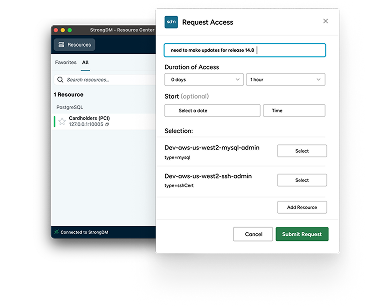

About the Author
StrongDM Team, Universal Privileged Access Authorization (UPAA), the StrongDM team is building and delivering a Zero Trust Privileged Access Management (PAM), which delivers unparalleled precision in dynamic privileged action control for any type of infrastructure. The frustration-free access stops unsanctioned actions while ensuring continuous compliance.
You May Also Like

